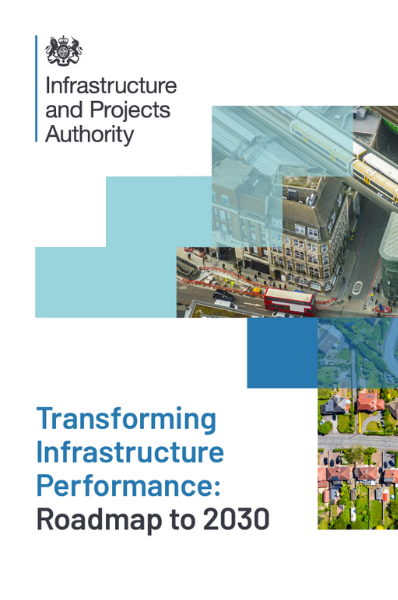A brief history
Most of the construction industry are now familiar with the UK BIM Mandate that was set out by the UK Government Construction Strategy in May 2011, detailing that for all centrally-procured public projects the ‘Government will require fully collaborative 3D BIM (with all project and asset information, documentation and data being electronic) as a minimum by April 2016’. With BIM Level 2 being developed to meet this mandate.
In 2018, the term ‘BIM Level 2’ was superseded by the UK Building Information Management (BIM) Framework, which was based on the emerging ISO 19650 series of standards and remaining BS/PAS 1192.
In 2021, the Government published ‘Transforming Infrastructure Performance (TIP): Roadmap to 2030′, the BIM Mandate was redefined as the ‘Information Management Mandate’ delivered through the application of the UK BIM Framework, being applicable immediately and for the duration of the TIP 10-year plan.

There are three key documents that interrelate and by following them, you are meeting the new mandate:
- Transforming Infrastructure Performance: Roadmap to 2030 – sets out a vision for innovation and reform in infrastructure delivery, with an objective to “end what is seen as artificial separation between infrastructure and construction”, and collectively prioritising societal outcomes.
- Construction Playbook – sets out key policies and guidance for how public works projects and programmes are assessed, procured, and delivered.
- National Infrastructure Strategy – sets out plans to transform the UK infrastructure in order to level up the country, strengthen the Union and achieve net zero emissions by 2050.



So…What is BIM Compliance and what legislation is currently in place?
There are two facets to BIM Compliance:
1. For a company, they need to be able to deliver projects in accordance with the UK BIM Framework which aligns to the international suite of industry standards, ISO 19650 series and remaining BS/PAS 1192. Attaining Business Systems Certification is a good measure of such compliancy, as achieved by Waldeck in 2021.
2. In terms of a project, this requires the application of the UK BIM Framework on the project and the Information Management process, detailed within BS EN ISO 19650-2:2018 being applied throughout the delivery phase of the assets, thus collaboration being key.
To support BIM Compliance, the BIM Protocol which was drafted back in 2013 for use with all common construction contracts and supporting BIM working at Level 2, has been updated to support the ISO 19650 series. The Information Management Mandate requires this protocol to be appended to contracts to ensure all procurement and contractual processes are compliant with the standards set out in the UK BIM Framework at the time of delivery.
What does it really mean to be BIM compliant?
In 2020, John Ford, BIM & Digital Delivery Lead, Galliford Try Construction, discussed ‘why it’s time for a BIM reboot’ after highlighting that his results depicted that the industry could be heading backwards with BIM, and calling for the public sector to re-energise the original 2011 objective.
Without placing blame, but with BIM starting and ending with the client, it is crucial that they understand what information they need, in whatever form, to be able to operate and maintain their asset upon handover. These specific requirements need to be clearly communicated within an Exchange Information Requirements (EIR), formerly known as Employer’s Information Requirements. Without an EIR being provided, then the project is not complying with the UK BIM Framework.
When should BIM be used for a project?
For public-funded projects, conformance to the UK BIM Framework is required on projects by the Information Management Mandate detailed within the TIP Roadmap to 2030 and by the Government’s expectations within the Construction Playbook, regardless of type (roads, rails, or buildings etc.) and size with societal impacts being at the centre of every decision.
Outside of public-funded projects, the implementation of BIM can relieve many challenges faced within a project, of any scale; the simple introduction of standards and processes for suppliers to align to, together with 3D coordination and data exchange mechanism (the Common Data Environment) provides a level of assurance to the client in the information being delivered during each phase of the project; design, construction and through to operation.
What are the benefits of using BIM on a project?
The adoption of BIM brings benefits at each stage of the project life cycle. Such benefits include.
- During design
- 3D coordination and design reviews will reduce design clashes, improve cost, and time certainty, facilitate informed decision making and generate a smooth transition to construction.
- Ability to access up to date information at any time throughout the project improving collaboration and communication.
- Dynamic simulation modelling forecasting the energy performance of the asset prior to construction and operation.
- During construction
- Ability to access up to date information at any time throughout the project improving collaboration and communication.
- Closer collaboration can lessen the number of variations and reduce waste on unused materials, reducing cost.
- Facilitates visualisation of construction progress
- Facilitates construction logistics planning
- Facilitates construction risk analysis and management
- During operation
- Handover and operation are transformed. Development of BIM data throughout the project stages can be integrated into the client’s asset management system creating a digital record that can be accessed and updated throughout the asset’s lifecycle.
How can Waldeck help with your BIM Compliance?
Waldeck have been utilising software supporting good information management for 10+ years and have been delivering BIM compliant schemes since the Government mandate in April 2016, gaining BRE BIM Level 2 Business Systems Certification in 2017 and more recently awarded with BRE ISO 19650-2:2018 Certification Scheme for Businesses in 2021, now being one of the first UKAS accredited schemes.
Waldeck’s BIM Consultancy team offers a holistic approach to BIM, providing our clients with the expertise to leverage competitive advantages and increased operational efficiencies, and knowledge to ensure the most effective digital design approach is deployed and compliant with the UK BIM Framework.
Our BIM Consultancy services support clients across four key areas:
- BIM Implementation
- BIM Support Services
- Project Information Management
- Strategic Information Management
Plus: Adding value through tailored solutions



1. BIM Implementation
Our BIM Implementation offering aligns digital transformation with organisational purpose, which is embraced throughout our clients’ organisation, and deeply integrated into the daily activities of their employees.
We work with our clients and their key stakeholders to implement the application of virtual tools, aligning to BS EN ISO 19650 standards to promote and ensure better collaborative working and performance monitoring.
Values adds of BIM Implementation on a project include:
- Whole lifecycle management
- Enhanced design
- Improved collaboration
- Improved efficiency
- Risk reduction
2. BIM Support Services and Training
Twinned with our BIM Implementation offering, our BIM Support Services and Training empowers our client’s internal teams with the knowhow to leverage the following benefits of BIM within their organisation and projects.
- Knowledge and understanding of industry leading modelling and project delivery standards
- A more efficient and higher standard design output than before
- Ability to provide improved deliverables for clients
- The skills to tender for Government funded projects (requiring UK BIM Framework)
3. Project Information Management
Our Project Information Management offering is compliant with the UK BIM Framework and sits at the heart of our project solutions. Our experts provide BS EN ISO 19650-2 information management activities associated with the role of Lead Appointed Party and Appointed Party ensuring the delivery of models and data at the defined project milestones, enabling our clients to benefit from data certainty throughout the lifecycle.
Value adds of Project Information Management include:
- Improved coordination and communication across supply chains
- Better quality information production
- Streamlined project activities
- Asset data supporting delivery and maintenance
- Smart operations
- Reduced risk of error
4. Strategic Information Management
Our Strategic Information Management offering sees our BIM Consultants working with our clients to understand their particular organisational and project information requirements and undertaking the BS EN ISO 19650-2 information management function of behalf of the client.
So… What’s next?
Waldeck have a wealth of knowledge applying BIM across a broad spectrum of infrastructure projects, therefore, contractor’s wanting to know more about BIM, and how through the appropriate level of BIM implementation within a project and aligning to BS EN ISO 19650 standards will benefit their delivery; then please feel free to contact us to speak with one of our specialists.
To find out more how Waldeck can support your next BIM projects, please contact Veronica Ruby-Lewis on 08450 990285 or via email: [email protected].
Frequently Asked Questions
BIM compliance refers to adherence to established standards and protocols for Building Information Modelling (BIM) in construction projects.
To ensure BIM level compliance, follow the guidelines set by your country’s regulatory bodies and implement the required processes and technologies.
BIM levels range from 0 to 3, representing increased collaboration and integration of digital processes in construction projects.
In the UK, BIM Level 2 compliance is mandatory for centrally procured government projects, with specific requirements outlined by the UK BIM Framework.
Yes, many organisations provide BIM compliance checklists. These typically cover areas such as data management, collaboration processes and technology implementation.
A BIM Level 2 compliance checklist should include items such as 3D modelling, data sharing protocols, and standardised file formats.
BIM Level 2 compliance involves collaborative 3D modelling with attached data, following specific standards and processes for information sharing and management.
Key BIM rules include using standardised data formats, following collaborative workflows, and maintaining consistent information throughout the project lifecycle.
To become BIM compliant, adopt the necessary software tools, train your team, and implement standardised processes aligned with industry guidelines.
BIM levels range from 0 (basic 2D CAD) to 3 (fully integrated 3D models with lifecycle management), with each level representing increased digital collaboration and integration.
ISO 19650 is an international standard defining collaborative processes for effective information management in BIM projects.
Key BIM standards include ISO 19650, PAS 1192 series (in the UK), and various national standards depending on your location.
ISO 19650 provides a framework for managing information throughout the lifecycle of built assets using BIM.
The Government/Industry BIM programme is a UK initiative to increase the adoption of BIM in the construction industry, setting standards and providing guidance.
BIM technology includes software and systems that enable the creation, management and sharing of digital representations of physical and functional characteristics of built assets.
BIM can help ensure compliance with building codes by incorporating regulatory requirements into digital models and facilitating checks throughout the design and construction process.
Ensure compliance by following industry standards, using appropriate software, training your team, and implementing quality assurance processes.
BIM can aid Building Safety Act Compliance by providing a comprehensive digital record of the building, facilitating better information management and traceability.
BIM Certification guidance outlines the requirements and processes for certification and is available from various professional bodies and standards organisations.
BIM maturity refers to the sophistication and integration of BIM processes within an organisation or project.
A BIM compliance checklist should cover areas such as data standards, collaboration processes, technology implementation, and alignment with relevant industry standards.
BIM requirements refer to the standards, processes, and deliverables expected in a BIM-enabled project, often defined by clients or regulatory bodies.
To obtain ISO 19650 certification, organisations must demonstrate compliance with the standard’s requirements through an audit process conducted by an accredited certification body.
BIM maturity level 2 involves collaborative working with 3D models and attached data, following specific standards and processes for information sharing.
Currently, there is no officially defined BIM level 4. The highest recognised level is BIM Level 3, which involves fully integrated and collaborative processes.
ISO 19650 is an international standard that provides a framework for managing information throughout the lifecycle of built assets using BIM.
BIM stages typically align with the RIBA Plan of Work, covering the entire project lifecycle from strategic definition to operation and use.
Glossary Of Terms
A digital representation of a facility’s physical and functional characteristics is used for decision-making throughout its lifecycle.
International standard for managing information over the whole life cycle of a built asset using BIM.
A data format for capturing and recording project handover data.
A standardized, digital description of the built asset industry.
A single source of information for collecting, managing, and disseminating documentation.
Describes the level of completeness to which a model element is developed.
A comprehensive document that defines how a project will be executed, monitored, and controlled in BIM.
A document outlining the information to be delivered and the standards and processes to be adopted by the supply chain.
The information model is developed during a project’s design and construction phase.
The information model is used to manage, maintain, and operate the asset.
A level of BIM maturity where separate discipline models are created, and information is shared through a common file format.
The process of identifying and resolving conflicts in a BIM model.
The integration of time-related information into a BIM model.
The integration of cost-related information into a BIM model.
A supplementary legal agreement that can be incorporated into construction contracts and professional service appointments.
A point of information exchange between the project team and the client at key project stages.
A model consisting of linked but distinct component models.
The ability of different systems or software to exchange and use information.
The party responsible for developing the content of a specific element of the building information model.
Publicly available standards that enable interoperability between different software applications.